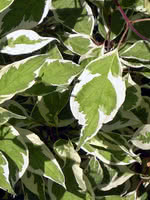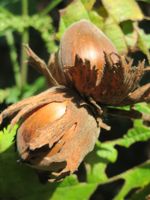Mon-Fri 9am - 5pm Mountain time
Variegated Dogwood vs European Hazelnut
Cornus alba argenteo-marginata
Corylus avellana
NOT AVAILABLE THIS SEASON - MIGHT RETURN
Variegated Dogwood is a small shrub that is often used in the first row of a shelterbelt, as a hedge, or for soil stabilization projects. It has the same distinctive red bark, white flowers, and berries as Red Osier Dogwood.
The key difference between the two is the leaves. Where Red Osier's leaves are green throughout, Variegated Dogwood has a white outline around each leaf, giving this shrub a distinctive look.
European Hazelnut is a large shrub that is native to Europe. It is known for its edible nuts that ripen in late summer to early fall. The nuts can be eaten raw or roasted and have a sweet, earthy flavour. Nut production can start as early as 2-3 years but typically takes until at least 4 years for significant yields.
Catkins appear in late winter to early spring and as they release pollen it attracts bees and other pollinators. Since male and female flowers bloom at different times, multiple shrubs will have to be planted for cross pollination. It is recommended to plant European Hazelnut with other hazelnut varieties such as Beaked Hazelnut, Frank, Yamhill, and York. Planting with other varieties will increase nut production.

